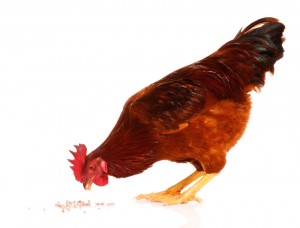Researchers at the University of Georgia Athens have found a link between bacterial pathogens on poultry farms and on processed chicken. The study was published online ahead of print in the journal Applied and Environmental Microbiology.
 The scientists evaluated “prevalences and loads of Salmonella and Campylobacter in farm and processing plant samples collected from 55 commercial broiler chicken flocks.” They found Salmonella in farm samples of 90.9% of the flocks and in processing samples of 94.% of flocks. Campylobacter was found in farm samples of 63.6% of flocks and in 87.3% of flocks. There was a significant positive relationship between environmental farm samples and processing plant carcass rinses with both of these bacteria. During processing, Salmonella prevalence dropped to 2.4% and Campylobacter to 43.6%.
The scientists evaluated “prevalences and loads of Salmonella and Campylobacter in farm and processing plant samples collected from 55 commercial broiler chicken flocks.” They found Salmonella in farm samples of 90.9% of the flocks and in processing samples of 94.% of flocks. Campylobacter was found in farm samples of 63.6% of flocks and in 87.3% of flocks. There was a significant positive relationship between environmental farm samples and processing plant carcass rinses with both of these bacteria. During processing, Salmonella prevalence dropped to 2.4% and Campylobacter to 43.6%.
Salmonella and Campylobacter cause about 1.9 million foodborne illnesses in this country every year. Poultry is a common source of both bacteria. A study ranking the importance of 104 different pathogen-food combinations listed Campylobacter and poultry first, and Salmonella and poultry fourth. Another study by Consumer Reports in 2010 found that 62% of chickens bought at supermarkets are contaminated with Campylobacter, 14% with Salmonella, and 9% with both bacteria.
But the focus on foodborne pathogen control in the U.S. chicken industry is focused on processing plants. Hazard analysis and critical control point programs (HACCP) became the law in 1996, and was made more stringent in 2011. Many processing plants use chlorinated water and chilling to reduce the microbial load on broiler carcasses, even though the magnitude of pathogen reductions is limited. Focusing on “pre-harvest management practices” could reduce the pathogen load further.
Recommendations by the USDA include having stringent biosecurity measures and sanitation practices on the farm, controlling litter moisture, using well-timed feed withdrawal before slaughter, using acids in chicken drinking water during feed withdrawal, vaccinating chickens against the bacteria, and screening chickens for pathogens before processing.
Unfortunately, there isn’t much data on pathogen concentrations between the farm and processing environments. In a press release, study author Roy Berghaus said, “this study suggests that reducing foodborne pathogen loads on broiler chicken farms would help to reduce pathogen loads at processing, and may ultimately help to reduce the risk of foodborne illness.”




